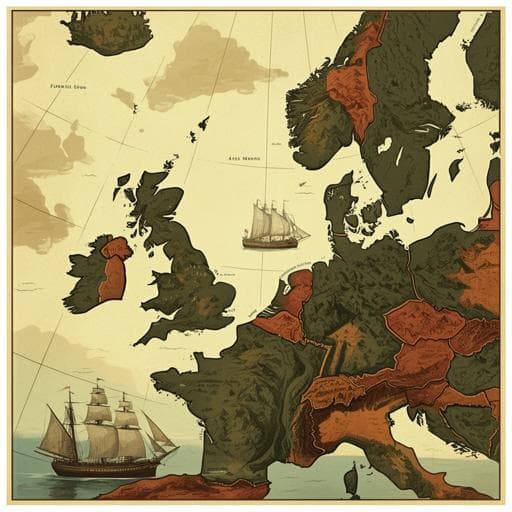
Transportation
A multi-criteria simulation of European coastal shipping routes in the 'age of sail'
A. D. Litvine, J. Lewis, et al.
This article unveils a groundbreaking method to model historical sailing routes, exploring real-world conditions while using extensive meteorological data. The research, conducted by Alexis D. Litvine, Joseph Lewis, and Arthur W. Starzec, sheds light on historical shipping corridors and offers for the first time journey-time metrics to and from all European ports.
~3 min • Beginner • English
Introduction
The study addresses the challenge of reconstructing historical coastal and short-sea shipping routes in Europe during the age of sail, where the lack of fixed infrastructure and sparse cartographic evidence hinder quantitative analysis. The authors hypothesize that a dynamic, multi-criteria simulation incorporating real environmental determinants (winds, waves, currents, visibility, extreme weather) and historical ship performance can reveal likely shipping corridors and seasonal routing patterns. By leveraging long-run meteorological reanalyses and historical constraints (bathymetry and coastal visibility), the purpose is to generate monthly routing predictions between European ports, validate them against historical evidence (logbooks, port books), and provide routable coastal networks and journey-time metrics to inform studies of historical transport costs, accessibility, and economic development.
Literature Review
The paper situates itself in established GIS and least-cost path (LCP) methodologies widely used in archaeology and digital humanities to model terrestrial movement (e.g., Verhagen et al., 2019; van Leusen, 1993; Fonte et al., 2017; Lewis, 2021; Beyin et al., 2019; Kealy et al., 2018). Sea-route modeling is comparatively recent, with archaeological applications to Viking, Mediterranean, Pacific Northwest, Caribbean, Southeast Asian, and prehistoric seafaring (e.g., Indruszewski and Barton, 2007; Leidwanger, 2013; Gustas and Supernant, 2017; Slayton, 2018; Perttola, 2021; Blankshein, 2021; Gal et al., 2021). Previous navigation LCP models often used simplified wind and bathymetry inputs, with some introducing anisotropy and limited seasonality. Historians have been slower to adopt such techniques due to abundant data complexities and computational skill gaps. The present work extends prior approaches by integrating multiple environmental variables and seasonality to more realistically model historical seafaring decisions.
Methodology
Overview: The authors develop a dynamic, multi-criteria least-cost routing framework for pre-steam navigation that integrates bathymetry, coastal visibility constraints, wind speed and direction, wind variability and gustiness, wave conditions (height, direction, period), and surface currents. The model outputs monthly optimal routes (both directions) for historical port pairs across Europe.
Data and assumptions:
- Climatic data: Monthly long-run averages derived from reanalysis datasets (primarily ERA-5) at hourly resolution for 1950–1978 for winds and waves; surface currents from OSCAR (1992–2020). Assumption: mid-20th-century averages approximate historical patterns within acceptable variance for modeling purposes, despite Little Ice Age variability.
- Historical ports: Combined datasets for England and Wales (Alvarez-Palau and Dunn, 2019), unpublished Scottish, Irish, Channel Islands data (Alvarez), and French ports (ANR Portic, 2023). Ports linked to the navigable area via zero-cost connectors.
Navigability constraints:
- Bathymetry: EMODnet DTM at 115 m grid. Cells with mean depth <10 m deemed non-navigable. To avoid unrealistic zigzagging near hazards, data resampled to 1.15 km cells taking maximum hazard value, ensuring ~≥500 m clearance from shallow areas.
- Coastal visibility (MPLVA): Derived using a DEM (EU Copernicus) and ArcPy visibility analyses to compute potential land-sight areas. Because constant land-sight is overly restrictive and real voyages intermittently lost sight, the authors constructed buffers representing ability to regain land-sight within 6h, 12h, and 24h. Empirical comparison with CLIWOC data led to adoption of MPLVA+12h as the navigable area (land-sight at least once every ~24h). Atmospheric horizontal visibility (fog) was analyzed from ASOS/NCEI/SYNOP to map monthly visibility patterns, but not used to constrain navigability due to threshold arbitrariness; instead, a visibility impairment coefficient is reported elsewhere.
- Optical aids: Given 17th–18th-century telescope availability and performance improvements, no additional degradation for naked-eye visibility was applied.
Ship performance and wind modeling:
- Ship characteristics: Representative square-rigged/coastal ship types (e.g., brigs/colliers) used to set draft and speed ranges from historical sources.
- Polars: Empirical polar data scarce; a brigantine (STS Young Endeavour) polar used with adjustments (reducing values <60° by 25%) to approximate square-rigged brigs; speeds interpolated for wind speeds 1–25 knots (hrosailing Python). Independent checks with Royal Navy and East India Company speed/wind observations (Kelly and Ó Gráda, 2018) set upper bounds.
- Winds: ERA-5 10 m U/V vectors converted to speed and direction. rWind used to compute wind connectivity across Moore neighborhoods. Transition costs incorporate apparent wind angle relative to course using the adjusted polars to estimate cell-wise boat speed VB as a function of wind speed and angle.
- Wind variability and gusts: For each cell, coefficients of variation (CV) for wind speed and direction were computed. Likelihood of extreme winds captured via ratio of mean speed to gust maximum (MoM). Transition costs weighted by CVspeed × CVdirection × MoM to reflect preference against highly variable or gust-prone areas.
Waves:
- ERA-5 wave direction (mean wave direction), significant wave height (SWH), and mean wave period (MWP). Speed-loss matrices adapted from Prpić-Oršić and Faltinsen (2012) provide lower-bound wave-induced speed penalties by relative wave angle and height. No-sail conditions flagged where wavelength ≤ 7 × SWH or SWH > 30% of average boat length. Wavelength estimated from period using depth-dependent formulas (after Earle, 2015).
Currents:
- Surface currents (to ~15 m) from OSCAR, monthly averaged. Treated as an independent component affecting transition costs (conveyor-belt effect). Tidal currents not included due to data unavailability (notably impacting English Channel in reality).
Model structure and simulations:
- Deterministic monthly simulations produce optimal paths for each direction and month per port pair (24 routes per pair). A stochastic approach (10,000 iterations/month) was initially tested but abandoned due to ignoring spatial co-dependencies among cells.
- Progressive model complexity across four variants: M1 baseline (winds with bathymetry/visibility), M2 adds waves, M3 adds currents (and wind–current interactions), M4 adds wind variability and gustiness. Twelve monthly runs per model.
Validation:
- Historical logbooks (CLIWOC): Compared monthly route densities and seasonal spatial shifts. Four key seasonal patterns matched (e.g., autumn southward shift into the Mediterranean via Moroccan coast; summer concentration NW of La Coruña; summer shift toward Portuguese coast; seasonal accessibility along English east coast toward Scotland).
- Port books (Dunn and Bogart): For 31 port pairs with ≥7 monthly observations, calculated observed monthly journey times and monthly-to-annual ratios. Model-derived journey times (including constant port-connector speed of 3 km/h) compared via ratios with bootstrapped CIs and outlier filtering.
- Modern routing engine (QtVlm): February routes for Newcastle–London, Le Havre–Marseille, Bristol–London, Liverpool–Dunkirk using NOAA data and historical square-rigger polars compared to model outputs; general similarity observed, with model showing additional complexity on longer routes.
Key Findings
- Currents increase average route length by about 20%: Adding surface currents (Model 3 vs Model 1) increased mean route lengths by approximately 20% on average while reducing the amplitude of seasonality in route length. Currents also offset some seasonality caused by winds.
- Seasonality is pronounced: Route length and journey time are highly seasonal, with deviations exceeding 30 percentage points from peak to trough over the year.
- Effects of successive model components:
- Model 1 (winds, bathymetry, visibility): Produced overly linear routes due to averaged wind fields; showed seasonal pattern with longer routes Feb–May (peak in March) and shorter Jun–Dec.
- Model 2 (adds waves): Negligible impact on routing choices and route length/seasonality, but increased average journey times via speed degradation.
- Model 3 (adds currents): Introduced significant spatial variation and less linear routes; increased average route length (~+20% vs M1) and dampened seasonality amplitude.
- Model 4 (adds wind variability and gusts): Restored a larger seasonal amplitude (with a shifted, more normal seasonal pattern) and further increased route length and spatial complexity.
- Regional heterogeneity:
- Mediterranean ports generally lose (longer/more complex routes) under more complex environmental modeling.
- In the British Isles, East Coast ports benefit most from complex modeling, while Irish and Welsh ports lose out—consistent with historical observations.
- Navigability and visibility constraints: Adopting MPLVA+12h as navigable area aligns best with historical CLIWOC routes. Extending beyond +6h to land-sight had little to no impact on average route length for tested routes; strict constant land-sight can imply unrealistic paths (e.g., Newcastle–London forced around Scotland).
- Validation consistency:
- CLIWOC seasonal density shifts: Four major seasonal patterns reproduced by the model (e.g., autumn southward shift into the Mediterranean; summer NW of La Coruña; summer shift along Portuguese coast; seasonal availability near English east coast–Scotland).
- Port-book journey times: Modeled monthly-to-annual ratios align with observed seasonal variability for 31 port pairs (after outlier filtering and accounting for port connectors).
- QtVlm comparison: Model routes broadly similar to modern routing outputs using NOAA data and historical polars, with added complexity on longer distances.
Discussion
The findings support the central hypothesis that a multi-criteria, seasonally dynamic routing model can recover plausible European coastal shipping corridors from the age of sail. Incorporating currents, waves, and wind variability produces route geometries and seasonal patterns consistent with historical evidence, while revealing significant regional disparities in how environmental factors shaped routing. The pronounced seasonality (over 30 percentage points deviation across months) and the average 20% increase in route length due to currents underscore the need to account for multiple environmental drivers when estimating historical distances, journey times, and costs. Validation against CLIWOC route densities captures known seasonal shifts, and comparisons with port-book journey time ratios suggest the model reflects real-world temporal variability, albeit as a best-case routing absent port delays and contingencies. The alignments with modern routing software further reinforce the plausibility of the modeled corridors. Collectively, the results demonstrate that environmental determinants strongly influenced historical route selection and that the proposed network provides a robust foundation for subsequent economic and historical analyses, such as assessing market access, freight cost dynamics, and regional specialization driven by coastal accessibility.
Conclusion
The study introduces an operational, multi-criteria simulation framework that generates monthly optimal routes between European ports in the age of sail by integrating winds, waves, currents, visibility, and bathymetry with historically grounded ship performance. It offers the first comprehensive journey-time metrics and a routable coastal network for pre-steam navigation, validated against historical logbooks, port-book journey times, and modern routing outputs. Key contributions include quantifying the average 20% route-length increase from currents, demonstrating strong seasonality in routing and journey time, and revealing regional differences (e.g., Mediterranean vs. British Isles east coast). The resulting datasets can be integrated into multimodal historical transport models to estimate end-to-end costs and accessibility impacts. Future work should refine coastal accessibility and freight cost inputs for all Europe, incorporate tidal current effects where critical (e.g., English Channel), and further bridge computational skill gaps among historians by disseminating methods and tools. The released code and data enable replication and extension to other regions and periods.
Limitations
- Climatic representativeness: Use of 20th-century reanalysis data (ERA-5 winds/waves 1950–1978; OSCAR currents 1992–2020) to approximate 16th–19th-century conditions may introduce biases, though assumed within variance of aggregated modeling.
- Best-case routing: The deterministic monthly averages and omission of many contingencies (extreme events, course changes, breakdowns, port delays, piracy, disease, quarantine) mean modeled routes represent best-case optimal paths rather than individual voyages.
- Missing tidal currents: Lack of tidal current data may affect accuracy in regions where tides dominate (notably the English Channel).
- Visibility handling: While horizontal visibility (fog) patterns were mapped, navigability was not constrained by an arbitrary visibility threshold; adoption of MPLVA+12h is empirically motivated but still a modeling choice.
- Data constraints: Historical logbooks for coastal coasters are scarce; validation relies on long-distance fleets (CLIWOC) and linked port books with necessary filtering. In-port and estuarial navigation effects (e.g., tug steamers post-1810s) were not modeled and could slightly bias comparisons for later periods (though primary port-book data used pre-1790s).
Related Publications
Explore these studies to deepen your understanding of the subject.







